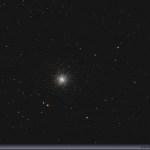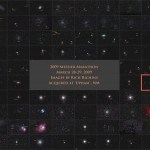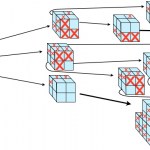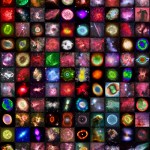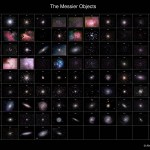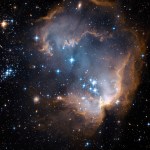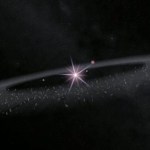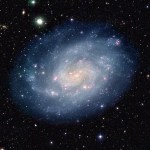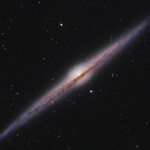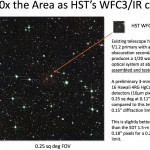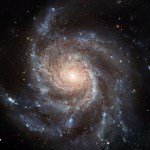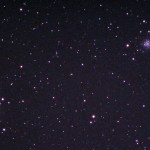Hubble
"If the sight of the blue skies fills you with joy, if the simplest things of nature have a message that you understand, rejoice, for your soul is alive." -Eleanora Duse
Welcome to another Messier Monday, where each week we take a look at one of the 110 deep-sky objects that make up the Messier Catalogue! One of the most common type of object in this catalogue is the globular cluster -- referred to by Messier as a round nebula (since he couldn't resolve them into individual stars) -- of which there are 29 in the catalogue.
Image credit: Deep Sky Observing, http://www.deepskyobserving.com…
"Modern man must descend the spiral of his own absurdity to the lowest point; only then can he look beyond it." -Vaclav Havel
But the spiral is more than a metaphor or a mathematical shape, it's also the most common feature observed in the galaxies out there in the Universe. There are 27 spiral galaxies in the Messier Catalogue, and today I want to show you how to find the most southerly of them all!
Image credit: Rich Richins, of all 110 Messier objects (in no particular order). M83 boxed.
The Southern Pinwheel Galaxy, also known as Messier 83, is a full 30 degrees south of the celestial…
"Forget it. I didn't have that thing inside me where I wanted to smash against somebody and watch them break. I was too sensitive for that and disliked being that sensitive." -Josh Brolin
How do you figure out what something is made of? You take it apart -- cracking it open if necessary -- and look inside. This is something we've been doing since... well, since before our ancestors were even human.
Images credit: Elisabetta Visalberghi.
For most things here on Earth, that's easy enough. If you wanted to go down to the smallest scales possible, however, it becomes harder and harder to "crack…
“The aim of science is not to open the door to infinite wisdom, but to set a limit to infinite error.” -Bertolt Brecht
One of the most frequent questions I get about the Universe -- as a cosmologist -- isn't quite about the Big Bang in and of itself.
The expansion of the Universe in reverse; image source unknown.
The Big Bang is a remarkable idea, of course, that says that, based on the observations that the Universe is expanding and cooling today, it was hotter, denser, and physically smaller in the past. This gets particularly exciting when we extrapolate very far back in the history…
"A colour is a physical object as soon as we consider its dependence, for instance, upon its luminous source, upon other colours, upon temperatures, upon spaces, and so forth." -Ernst Mach
Our Sun, like all Sun-like stars, will come to the end of its life someday. All the hydrogen fuel in its core will eventually burn up, and when this happens, the core itself will begin to contract. When temperatures are finally high enough, the end product of hydrogen fusion -- Helium-4 -- will begin to fuse in the contracted core, and the Sun will expand into a Red Giant.
Image credit: Northwestern…
"It took less than an hour to make the atoms, a few hundred million years to make the stars and planets, but five billion years to make man!" -George Gamow
Earlier today, a video (from last month) was released where one of the members of the US House of Representative -- a member who sits on the House Committee for Science, Space and Technology -- proudly proclaimed the following:
"All that stuff I was taught about evolution, embryology, the big bang theory; all of that is lies straight from the pit of hell." -Paul Broun
Well, if the Big Bang is a lie from the pit of hell, then the…
"It is by going down into the abyss that we recover the treasures of life. Where you stumble, there lies your treasure." -Joseph Campbell
One of the bravest things that was ever done with the Hubble Space Telescope was to find a patch of sky with absolutely nothing in it -- no bright stars, no nebulae, and no known galaxies -- and observe it. Not just for a few minutes, or an hour, or even for a day. But orbit-after-orbit, for a huge amount of time, staring off into the nothingness of empty space, recording image after image of pure darkness.
What would we find, out beyond the limits of what…
"The self-same atoms which, chaotically dispersed, made the nebula, now, jammed and temporarily caught in peculiar positions, form our brains; and the 'evolution' of brains, if understood, would be simply the account of how the atoms came to be so caught and jammed." -William James
Up in the heavens, there are planets, stars, and galaxies all clearly visible in the night sky.
Image credit: Dan & Cindy Duriscoe, FDSC, Lowell Obs., USNO.
But those stars weren't always there, and they won't be there forever. The other class of object in the night sky -- the nebulae -- come in two…
"Not even light can escape such hollowing, this huge mass in a small space. Even the Milky Way with its open arms is said to have a black hole at its heart." -Susan B.A. Somers-Willett
Our Milky Way is home to us all. With its hundreds of billions of stars, massive spiral arms, dust lanes, and orbiting globular clusters, it's no wonder that nearly everything we see in the night sky is contained within it.
Image credit: All rights reserved by Flickr user Greg Booher.
I say nearly everything, of course, because there are a few exceptions. The Andromeda Galaxy, for one, as well as…
"I have announced this star as a comet, but since it is not accompanied by any nebulosity and, further, since its movement is so slow and rather uniform, it has occurred to me several times that it might be something better than a comet. But I have been careful not to advance this supposition to the public." -Giuseppe Piazzi, discoverer of Ceres, the first Asteroid
Out beyond Mars, but not quite out as far as Jupiter, a collection of thousands of rocky objects, ranging in size from pebbles all the way up to the size of Texas, lies the asteroid belt.
Image credit: David Minton and Renu…
“At the last dim horizon, we search among ghostly errors of observations for landmarks that are scarcely more substantial. The search will continue. The urge is older than history. It is not satisfied and it will not be oppressed.” -Edwin Hubble
While new discoveries are made about the Universe, a new explorer finds its way on a foreign world, and the world bids farewell to a legend, my old favorite -- the Hubble Space Telescope -- keeps amazing us all.
Image credit: NASA / STS-125, Space Shuttle Atlantis, Ruffnax (Crew of STS-125).
Now more than 22 years into its continuing mission, this…
"We don’t understand how a single star forms, yet we want to understand how 10 billion stars form." -Carlos Frenk
The Universe has been around for a long time: nearly 14 billion years, to the best of our knowledge. When it was very young, there were absolutely zero stars in it, while today, there are hundreds of billions of galaxies, each of which contains anywhere from a few billion to many trillions of stars.
Image credit: NASA, ESA, and the Hubble Heritage (STScI / AURA) - ESA / Hubble Collaboration
The galaxy shown above, NGC 2841, is very similar to our own Milky Way.…
This spring, the Hubble outreach office started a Hubble Treasure Hunt
The challenge was to browse through the Hubble raw data archives, and look for undiscovered images, ones that had not been published and were interesting or beautiful.
There are a lot of Hubble images.
The finalists for the contest have now been announced, in two different categories: one for unprocessed images; the other for processed images.
The decision on the winners, will be done by public vote, and the selection of finalist images is up on the web and open for voting:
unprocessed images are here
processed images…
"If you don't like what you're doing, you can always pick up your needle and move to another groove." -Timothy Leary
Up in the night sky, shortly after sunset, the night sky holds some spectacular sights. Some are permanent, some are transient, some have been known for thousands of years, and some are still being discovered. Looking to the west after sunset tonight, this is what you're likely to see.
Image credit: Me, using Stellarium, available free at http://stellarium.org.
The Big Dipper, perhaps the most famous collection of seven stars in the night sky, looms large over the horizon. As…
"Everyone is a moon, and has a dark side which he never shows to anybody." -Mark Twain
Back before the telescope was invented, Saturn was known as the Old Man of the Skies. The slowest-moving of the naked-eye planets, it's the only one that would reliably be in nearly the same location, year after year. You can find it all summer, after sunset, by following the "arc" of the handle of the big dipper all the way until you run into the brightest northern-hemisphere star, Arcturus, and then speeding on to the very bright Spica. Saturn is right next door.
Image credit: EarthSky.org.
But…
In which NASA gets presented with two Hubble class wide field space telescopes...
Oh my. So some of the mysterious maneuverings at NASA's Astrophysics division can now be better understood.
The National Reconnaissance Office was sitting on a couple of spare space telescopes they are willing to transfer to NASA.
These are presumably late block Keyhole reconnaissance satellite spares, maybe even the two extras orders a few years ago at the end of the program.
So, state of the art as of 10-20 years ago.
We are looking at two partial telescopes, with a Hubble size primary mirror, 2.4m, but…
"This seems to be the law of progress in everything we do; it moves along a spiral rather than a perpendicular; we seem to be actually going out of the way, and yet it turns out that we were really moving upward all the time." -Frances Willard
As spring gives way to summer here in the Northern Hemisphere, one of the most beloved sights of the night sky becomes ever more prominent: the Big Dipper.
(Image credit: NASA, ESA, Z. Levay (STScI) and A. Fujii.)
These seven bright stars shine high above the horizon after sunset, and will continue to do so over the rest of the Spring and all Summer…
"The Earth's atmosphere is an imperfect window on the universe... atmospheric turbulence blurs the images of celestial objects, even when they are viewed through the most powerful ground-based telescopes." -John Bahcall
There's no doubt that the Hubble Space Telescope has given us some of the most spectacular, high resolution views of the Universe. From the most distant galaxies ever seen to stars here in our own galactic backyard, the Hubble Space Telescope has simply dwarfed anything we've been able to do from Earth's surface.
Image credit: Bill Drelling.
This is the globular cluster NGC…
"We find them smaller and fainter, in constantly increasing numbers, and we know that we are reaching into space, farther and farther, until, with the faintest nebulae that can be detected with the greatest telescopes, we arrive at the frontier of the known Universe." -Edwin Hubble
While large parts of the internet are blacked out today, in protest of SOPA and PIPA, I could think of no better way to highlight the importance of free exchange of information on the internet than by showcasing one of the most interesting, varied and intricate objects in the entire galaxy: Messier 16, better known…
"Nothing leads the scientist so astray as a premature truth." -Jean Rostand
One of the most awesome events, literally, that happens in this Universe is when stars -- giant nuclear furnaces like our Sun -- die in the most energetic way possible: a supernova.
Video credit: Max-Planck-Institut für Astronomie (Ors Hunor Detre, Oliver Krause), via YouTube.
Every star that ever lived gets two chances to end their lives in this most spectacular of fashions. The hottest, bluest, most massive stars that are born burn through their nuclear fuel incredibly rapidly, accumulating a core of heavy metals…
